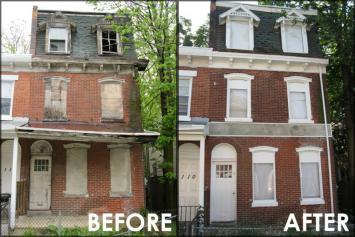America’s Crown Communities 2011
What is in this article?
- America’s Crown Communities 2011
- Schools Recycling Partnership Program (Cathedral City, Calif.)
- Chandler City Hall (Chandler, Ariz.)
- Wastewater Collection System and Wastewater Treatment Plant Expansion (Pharr, Texas)
- Vacant Property Management Strategy (Philadelphia)
- City Hall Fellows (San Francisco)
- Health District Consolidation (Summit County, Ohio)
Vacant Property Management Strategy (Philadelphia)
 Philadelphia has battled blight problems resulting from vacant buildings for 50 years, but the problem has continued to grow. This year, the city’s Department of Licenses and Inspections (L&I) created a program to deal with vacant properties once and for all, and progress already is being made.
Philadelphia has battled blight problems resulting from vacant buildings for 50 years, but the problem has continued to grow. This year, the city’s Department of Licenses and Inspections (L&I) created a program to deal with vacant properties once and for all, and progress already is being made.
“This strategy is important because we have [more than] 20,000 vacant structures in the city,” says City Commissioner Fran Burns. “They breed a nuisance problem. Sometimes it’s criminal activity, sometimes it causes repair problems for neighboring buildings, and sometimes animals and people take shelter in these vacant structures. For those living with a vacancy in their neighborhoods, it really can be a source of daily difficulties.”
In January, L&I identified 25,000 unoccupied structures and instituted a Vacant Property Management Strategy to hold owners more accountable for the maintenance of their vacant properties. The city started with a pilot program targeting vacant structures in census tracts with low occupancy rates. The program includes a three-pronged approach:
1. Finding the owners. Researchers use several databases to obtain current names and addresses of the owners of vacant properties.
2. Increasing enforcement. The city has new powers to penalize owners of a large number of vacant, blighted properties and attach liens to their personal assets. The city is enforcing its “doors and windows” ordinance, allowing L&I to charge owners $300 per day for every opening that is not covered with a functioning door or window.
3. Dedicating court time. The city has established dedicated days for local courts to hear cases in the First Judicial District, ensuring the swift handling of vacancy cases.
L&I also is contacting neighbors and community groups near the vacant properties to get the word out about vacant properties for sale to help sell the properties and get them inhabited. Reducing the blight has led to an increase in neighborhood values and an increase in safety. For example, since the pilot began, 25 percent of owners cited for rental license violations have obtained licenses, 13.5 percent of owners cited for vacant property license violations have acquired licenses, 14.6 percent of owners cited for vacant exterior violations have complied, and 7.5 percent of doors and windows violations have complied, all without any legal action.
With such success in the pilot program, L&I is now expanding the program in four phases, with each phase focusing on census tracts with greater numbers of vacant, blighting properties. “We’ve had some very positive press locally, and it’s clear that people really want this,” Burns says. “With a little initial success, we’re hoping to build momentum and nip blight in the bud before it happens.”
















